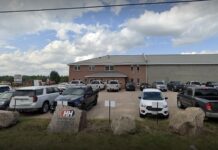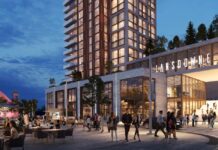Near zero energy consumption can be achieved at near zero cost, say advocates
Ottawa Construction News staff writer
Can we build residential, institutional and commercial structures that consume virtually no energy, at initial construction costs close to conventionally-built structures, while providing sustainable and high comfort, in any kind of climate?
The answer, says Gunter Lang, leader of the Austrian national Passivhause (Passive House) network, is “yes” – and in the process, he says the international climate change problem could be be resolved without complex or draconian measures.
Lang and Malcolm Isaacs, director of the Canadian Passive House Institute (CanPHI), outlined the performance-based Passive House concept at a Construction Specifications Canada (CSC) Ottawa chapter event on Sept. 26.
Close to 200 individuals and organizations, including designers, contractors, building industry suppliers and students, paid $30 each to attend the program at the Overbrook Community Centre.
Lang demonstrated completed European Passive House projects including schools, apartment building retrofits, commercial skyscrapers, and institutional buildings – even a prison – to show the concept doesn’t just work for residential single-family homes. In fact is easier to implement and achieve in larger structures (because the bigger the building size, if designed properly, the easier it is to manage the insulation systems to achieve heating and cooling efficiencies.)
He also showed how the concept has been applied in the world’s harshest environments including an Antarctic research station, and how it works in warmer climates, where the issue is less heating than air conditioning and cooling.
In each situation, the concept doesn’t require extraordinary expense, though Isaacs and Lang acknowledge there are challenges in North America because of the lack of Passive House-certified building products.
Lang said, to solve the risk of climate change, “industrialized countries have to reduce carbon dioxide emissions a minimum of 25 to 40 per cent by 2020 and by 80 to 90 per cent by 2050.”
This daunting challenge puts a major weight on the building sector, one of the world’s largest energy consumers. However, Lang said if buildings could be constructed to use virtually no energy, through passive rather than active technologies, the world would be well on the way to solving the climate change threat.
There wouldn’t be a need to develop the oil sands, shale oil fracking, nuclear or even massive natural gas plants, because the energy conserved through Passive House design implementation would be far less expensive than the costs required to build new energy production capacity.
In a conversation after the presentation, Lang indicated the biggest problems in Passive House implementation relate to political and economic self-interests fighting against their market-share loss.
He indicated initiatives to introduce and expand the concept have been thwarted in part because of lobbying from the energy industry and other businesses that would lose market opportunities if the concept is implemented.
The circumstances in North America are somewhat different, Isaacs said. The concept is new, and Canadian building supply manufacturers have yet to introduce products that meet the Passive House standards, especially in the vitally important fenestration area, where most energy loss occurs.. Isaacs said the highest current Canadian fenestration standards would be appropriate, in the Passive House model, for homes and buildings in southern Florida.
Isaacs demonstrated a 1,500 watt duct heater, “basically a toaster in technology” – that could replace a conventional furnace in a 1,600 sq. m. passive house.
“The Passive House is very energy efficient and can be heated mainly with passive house sources, such as the sun in the window, the occupants (body heat), the fridge, and so on),” he said.
“You do need heat recovery and you must have a mechanical ventiliation system,” he said.
Early efforts at what have become the Passive House concept involved complex and challenging systems, and current “net zero” homes – with solar arrays and other techniques to generate energy – have been fraught with complexity and cost. These systems are often difficult to maintain, and therefore unsustainable.
Isaacs said he visited one of the earliest experimental Canadian houses in Regina, built in the 1970s. It featured then-state-of-the-art innovations including solar panels and a heat storage system in the basement. The house is still occupied, but the fancy stuff has long been removed – what remains, he said, are the Passive House components. He asked the homeowner about the house’s energy bill; and the resident said he didn’t know, because it is still so low.
Lang suggested that Passive House construction should not require more than two to five per cent initial costs greater than conventional construction, with energy savings and payback occuring from day-one. The concept may require more expensive and sophisticated insulation and fenestration with advanced heat recovery/ventiliation systems, but because the project uses so much less energy, you don’t need conventional (or even more expensive high-efficiency) furnaces – the overall HVAC systems are much less expensive than conventional ones.
Isaacs acknowledged there are still challenges in introducing the concept in Canada. He cited an institutional building constructed to Passive House standards in the GTA that still needed, because of Ontario Building Code requirements, a full boiler room, with supporting infrastructure – even though the building doesn’t need anywhere near a boiler to generate its heat.
As well, there still is a shortage of products that have been certified to Passive House standards.
This means designers planning projects need to arrange custom solutions – requiing greater expense to test and verify their value – or they must import building products from Europe or elsewhere.
These are among the challenges that CVS Architects will experience in designing Salus House, Otaawa’s first multi-storey Passive House project. The 42-unit structure is being designed for people with mental illnesses, who would otherwise be homeless.
Lisa Ker, Salus’s executive director, says she beliees the Passive House construction, which will mean the project will have virtually no energy costs for heating and air conditioning when it is completed, will provide genuine savings to taxpayers over many years, and the costs of building to Passive House standards shouldn’t increase the initial construction budget significantly. (The project has run into delays, not because of its design, but because some neighbours – objecting to the possibility of mentally-ill people living in a 42-unit residence in their neighbourhood – have appealed against the project to the Ontario Municpal Board.)








